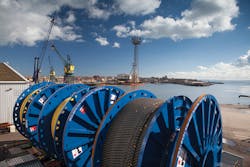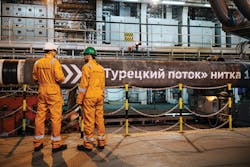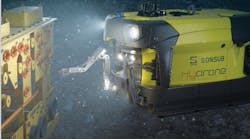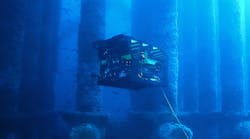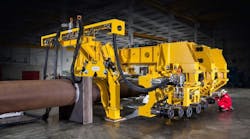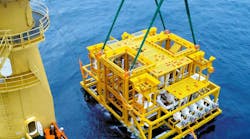Jessica Tippee • Houston
Oceaneering wins umbilical order for Vito
Subsea 7 has contracted Oceaneering International Inc. to supply an umbilical and flying leads for Shell’s deepwater Vito development in the Mississippi Canyon area of the US Gulf of Mexico.
The contract is for an electro-hydraulic steel tube control umbilical, and flying leads, totaling about 9 km (5.6 mi) in length. Product design and engineering will start in 3Q 2018, with manufacturing expected to begin in 2019, at Oceaneering’s facility in Panama City, Florida. The contract work scope is expected to be completed by 2Q 2020.
Alan R. Curtis, Oceaneering’s senior vice president and CFO, said: “We are very pleased to have won this contract with Subsea 7 and the opportunity to provide subsea products for another of Shell’s deepwater projects. This, and other recent contract awards, give us increased confidence in the improving levels of offshore activity, as we have been anticipating.”
Wild Well, JDR sign long-term service agreement
Wild Well Control Inc., a Superior Energy Services company has awarded JDR Cables Systems (JDR) a five-year long-term service agreement. The five-year agreement will see JDR design, manufacture, and assemble intervention, workover and control systems (IWOCS) to be deployed in conjunction with Wild Well’s 7Series subsea intervention systems.
Under the long-term service agreement, JDR will design, manufacture, and assemble intervention, workover and control systems (IWOCS) to be deployed in conjunction with Wild Well’s 7Series subsea intervention systems. (Courtesy JDR)
The 7Series subsea intervention system enables operators to conduct deepwater live well interventions and/or plug and abandonment operations with improved safely and efficiently. The agreement with JDR includes Generation I and II of the 7Series technology – the latter allows operators to switch “on the fly” between riser-less and riser-based deployment functions without resurfacing.
To facilitate a cost-effective roll out, each company will cross-train the other’s respective employees to optimize project personnel and generate additional savings for operators.
Data-driven SCR design JIP enters next phase
2H Offshore has completed the first phase of the STREAM (STeel Riser Enhanced Analytics using Measurements) joint industry project (JIP) and has expanded the work into a second phase.
The JIP’s participants include Anadarko, Chevron, ExxonMobil, and Shell. In this collaborative effort, field data from four deepwater steel catenary risers (SCR) and one lazy-wave riser were used to provide a measurement-based foundation for riser modeling.
According to 2H, the data analysis revealed a wealth of information on riser wave-induced, vortex-induced (VIV) and heave-induced vibration response. The JIP determined that industry-standard analysis methods for wave and VIV fatigue are often conservative and thus lead to increased costs and prolonged schedules. The JIP quantified the level of conservatism and determined a realistic set of parameters that match the measured data better.
These findings, the company said, provide significant value to upcoming projects’ design and life extension assessments through improved efficiency in riser design and analytical predictions.
Ilkay Darilmaz, a Shell research engineer, said: “Through the STREAM JIP, structural monitoring data from a range of risers has helped us to identify common opportunities for improved fatigue life predictions. This will enable us to implement safer and more efficient SCR and lazy-wave designs going forward.”
Phase two of the STREAM JIP will start in 2019 with additional datasets for validating the phase one findings further. Heave-induced vibration observed in field measurements will be isolated and analyzed to help understand this phenomenon better. Lazy-wave buoyancy hydrodynamics, SCR seabed interaction and extreme storm response are other key areas of focus for phase two.
2H invites interested industry partners to join the JIP.
TurkStream pipelay enters final phase
Construction of the TurkStream gas export facilities in the Black Sea is progressing as scheduled, according to operator Gazprom. Allseas’ Pioneering Spirit began laying the second of the parallel gas lines in late June. By early September, more than 1,520 km (944 mi) of the two strings had been completed, representing around 81% of the overall length of TurkStream’s offshore section.
About 81% of the overall length of TurkStream’s offshore section has been completed. (Courtesy Gazprom)
Gazprom added that the landfall near Anapa in Russia had been completed and that start-up/commissioning operations should finish later this year. A reception terminal is under construction in the coastal area near Kiyikoy, Turkey.
The first string of TurkStream is dedicated to Turkish consumers, while the second will deliver gas to southern and southeastern Europe. Each string will have a throughput capacity of 15.75 bcm/yr.
South Stream Transport is responsible for construction of the offshore pipelines. •


